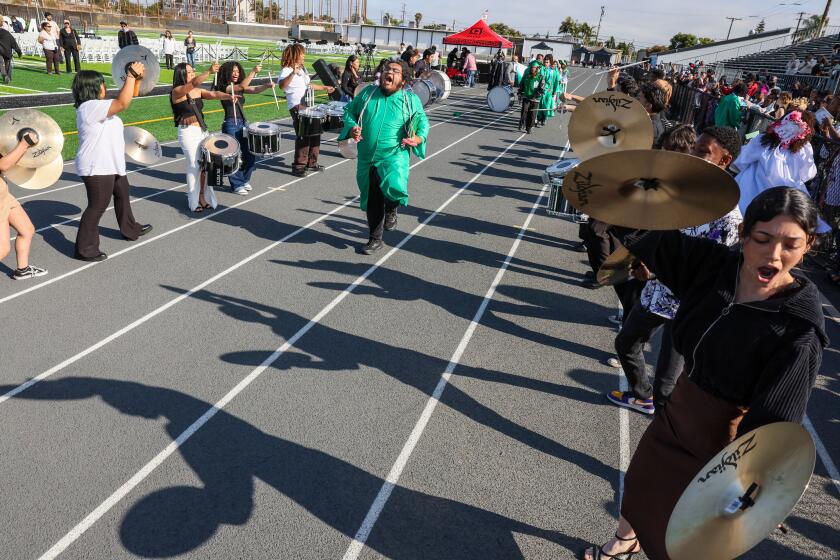Student Faces Up to Discrimination of Cruel Yearbook Hoax
Tom Lee is the first to say that he does not look--to use his own word--”normal.”
Tom was born 18 years ago with an unusual growth disorder that impaired the development of the right side of his body. His face is misshapen, his right ear is slightly cupped and his right arm and hand are crooked. The unusual shape of his jaws occasionally slurs his speech.
This week, Tom learned that students at a rival school reproduced his photograph in their yearbook.
As a joke.
So on Friday afternoon he drove to the Harvard School, the prestigious Studio City institution that produced the yearbook, to gather evidence for his cause. He borrowed a copy of the book from the headmaster’s office to show administrators at the Buckley School--the prestigious private school that he attends--so they could protest on his behalf.
Childhood cruelties are nothing new, of course. Anyone who has ever been too fat, too tall or too skinny can tell you that. All about us are grown men and women still reacting, or overreacting, to some playground taunt the taunter never thought of again.
Economic status should not necessarily be an issue here, but it is hard to ignore Harvard’s sterling reputation and sterling student body. A place where money and brains become the fast track to the Ivy League is an emotionally easy target for outsiders. But poor taste knows no class boundaries.
Money can buy lots of things, but common decency and compassion carry no price tags. As Tom put it: “They are Harvard people. Harvard students should be above all this.”
Tom told a white lie to borrow the book Friday. He said he was with the Buckley yearbook staff--which is true--and wanted to see Harvard’s book for “guidance.”
He didn’t stay long in the Harvard School parking lot and was unsure whether his complaint would amount to anything. But he had to do something, Tom said. After a lifetime of jokes and stares--in grade school kids called him “retard” and mimicked his facial expressions--he decided to strike back.
Yearbooks stay around forever, Tom explained. Years from now, people will look at that photograph and somehow, he will know it, he said. “This is permanent.”
Tom, a Hollywood resident, first saw the yearbook on Wednesday afternoon at a friend’s house.
“Did you cry?” he was asked.
He paused. “I hardly ever cry now.”
The photograph was taken seven years ago when Tom was in the fifth grade, his first year at Buckley, in Sherman Oaks. Taunts there were somewhat fewer than in public school. He still prefers the company of adults to small children. “I don’t go around them,” he said. “I just get stares.”
He thinks the photo shows him “when I looked my worst. I have a very weird-looking haircut, my mouth is open. I tried to smile.” His long hair hid his deformed ear.
Tom’s picture was one of several from old Buckley yearbooks sprinkled through the class photos of the Harvard album. The Harvard students also ran photographs of celebrities with humorous IDs. Roseanne Barr became “The Blob” and Jack Nicholson “The Joker.”
Beside Tom’s face they wrote “Shazzam.” Tom thought it was an exclamation of disgust at his face.
Perhaps it was. Or perhaps some Harvard student editor is a comic-book scholar: The phrase originated, more than 40 years ago, as the magic word a pitiful crippled newsboy would utter to transform himself into the super hero, Captain Marvel.
Say the magic word, Tom, and maybe you’ll be transformed too?
The Harvard headmaster and the faculty adviser to the yearbook could not be reached for comment. But Steve Shaw, a new yearbook adviser who will take over next semester, said he would not allow such a thing in the future.
“I don’t know what people were thinking,” he said when told of Tom’s photo.
Shaw promised that things will be different under his tenure and that perhaps lessons can be learned from this experience. “I now have another lecture,” he said.
Tom will undergo cosmetic surgery this summer. Doctors had to wait until he stopped growing so they could try to balance the features on his face.
He is a serious and quiet young man who likes tennis and cycling. “Usually, I can do anything that I want to,” he said, despite his withered right arm. He hopes to be a lawyer.
He has no religion. “I used to believe in God, but I thought twice about it.”
Why take a yearbook photo at all, he was asked. Didn’t he hate them?
He did, he recalled. But he had to allow his picture to be taken because “everyone has their yearbook photo taken.” He has wrestled with the urge to hide and a thwarted desire to belong all his life.
A few months ago, Tom and his family attended a performance of “Phantom of the Opera,” the tragic story of the misshapen man behind the mask.
“You know how his face is half covered by a mask?” he asked. “I just related to him in some of the scenes, like when the girl fainted when he exposed himself and removed his mask. It reminded me of myself.”
But Tom learned something too. In the story, the phantom lives in the shadows under the opera house, away from the world, with his bitterness. It made him think, Tom said, made him realize that the phantom took the wrong way out by hiding.
“I want to be part of life,” he said.
And that’s why he was at Harvard Friday, to con them out of a copy of the book.
He isn’t hiding.



